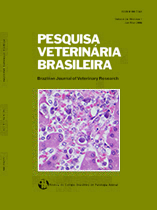 |
|
|
|
Year 2015 - Volume 35, Number 2
|

|
Morphology of salivary glands of the Glironia venusta Thomas, 1912 (Didelphimorphia), 35(2):199-207
|
ABSTRACT.- Vieira B.S., Schuingues C.O., Lima M.G., Martins D.S. & Costa G.M. 2015. [Morphology of salivary glands of the Glironia venusta Thomas, 1912 (Didelphimorphia).] Morfologia das glândulas salivares de Glironia venusta Thomas, 1912 (Didelphimorphia). Pesquisa Veterinária Brasileira 35(2):199-207. Universidade do Estado de Mato Grosso, Campus I, Rodovia MT-208 Km 147, Jardim Tropical, Alta Floresta, MT 78580-000, Brazil. E-mail: bruna_sakamotovieira@hotmail.com
The aim of this study was to describe the morphology of the salivary glands of Glironia venusta. A sample of G. venusta was collected in fauna rescue of hidroelectric usine of Teles Pires was used. This exemplar was fixed with formaldehyde solution 10%. For macroscopic analysis, the glands were dissected and photographed in situ and for the microscopy fragments of the glands were removed, that were dehydrated in increasing alcohol concentrations, diaphanizated in xylene, included in paraffin and stained with hematoxylin and eosin. G. venusta presented the mandibular, parotid, sublingual, labial and zygomatic glands. The mandible is shown as elongated structures, composed of non-septated lobes and located in the anterior cervical region. With a triangular format, the parotid was located in the depression of the masseter, ventral an auricular cartilage. The sublingual were located ventral to the mandible, caudal to the digastric muscle. In the posterior dorsal portion, until the labial commissure, dorsal to the orbicularis muscle of mouth was observed the labial glands, which showed a “U” shape. The zygomatic glands was accompanied the shape of the anterior portion of the zygomatic arch at the infraorbital margin. The mandibulars and sublinguals glands showed acini of mucous type, with some serous acini. The parotid one was made up purely by serous acini. In the labial gland was observed acini of mixed types mixed or seromucosous. Related the zygomatic gland was not possible to perform the microscopic analysis because of histological proceeding problems. Characteristics of the salivary glands observed in G. venusta resemble other omnivores mammals, but showed small differences as regards their location and shape. |
| |
|
|
| |
|
 |